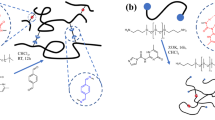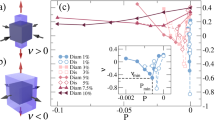Abstract
The three-dimensional structures of polymer networks are formed through two types of crosslinks: static and dynamic. Although the characteristics of crosslinks strongly influence the rheological properties of polymer networks, the understanding of the molecular origin of these properties remains incomplete owing to structural complexity. The relationship between the structure and dynamics of polymer networks and their rheological behavior can be elucidated based on multiple experimental methods. From this viewpoint, this review introduces rheological studies on static and dynamic polymer networks. Investigations of the nonlinear elastic behaviors of model static networks (Tetra gels) through general biaxial stretching revealed that a cross-effect of strains in different directions is present, even in networks without defects, which is not considered in conventional molecular models. Linear viscoelastic and spectroscopic studies on dynamic networks (host–guest gels and hydrophobically modified ethoxylated urethane) have shown that conventional molecular models are not suitable for describing rheological properties. Dynamic heterogeneities, such as the different mobilities of rotaxane-like crosslinks and micelles, strongly influence the rheological properties. These results demonstrate the remaining issues to be investigated to obtain a molecular understanding of the rheological properties of polymer networks.
This is a preview of subscription content, access via your institution
Access options
Subscribe to this journal
Receive 12 print issues and online access
$259.00 per year
only $21.58 per issue
Buy this article
- Purchase on Springer Link
- Instant access to full article PDF
Prices may be subject to local taxes which are calculated during checkout







Similar content being viewed by others
References
Gong JP, Katsuyama Y, Kurokawa T, Osada Y. Double-network hydrogels with extremely high mechanical strength. Adv Mater. 2003;15:1155–8.
Okumura Y, Ito K. The polyrotaxane gel: a topological gel by figure-of-eight cross-links. Adv Mater. 2001;13:485–7.
Sakai T, Matsunaga T, Yamamoto Y, Ito C, Yoshida R, Suzuki S, et al. Design and fabrication of a high-strength hydrogel with ideally homogeneous network structure from tetrahedron-like macromonomers. Macromolecules. 2008;41:5379–84.
Haraguchi K, Takehisa T. Nanocomposite hydrogels: a unique organic–inorganic network structure with extraordinary mechanical, optical, and swelling/de-swelling properties. Adv Mater. 2002;14:1120–4.
Yesilyurt V, Webber MJ, Appel EA, Godwin C, Langer R, Anderson DG. Injectable self-healing glucose-responsive hydrogels with pH-regulated mechanical properties. Adv Mater. 2016;28:86–91.
Nakahata M, Takashima Y, Harada A. Highly flexible, tough, and self-healing supramolecular polymeric materials using host–guest interaction. Macromol Rapid Commun. 2016;37:86–92.
Kakuta T, Takashima Y, Nakahata M, Otsubo M, Yamaguchi H, Harada A. Preorganized hydrogel: Self-healing properties of supramolecular hydrogels formed by polymerization of host–guest-monomers that contain cyclodextrins and hydrophobic guest groups. Adv Mater. 2013;25:2849–53.
Nakahata M, Takashima Y, Yamaguchi H, Harada A. Redox-responsive self-healing materials formed from host–guest polymers. Nat Commun. 2011;2:511.
Sun TL, Kurokawa T, Kuroda S, Bin Ihsan A, Akasaki T, Sato K, et al. Physical hydrogels composed of polyampholytes demonstrate high toughness and viscoelasticity. Nat Mater. 2013;12:932–7.
Yesilyurt V, Ayoob AM, Appel EA, Borenstein JT, Langer R, Anderson DG. Mixed reversible covalent crosslink kinetics enable precise, hierarchical mechanical tuning of hydrogel networks. Adv Mater. 2017;29:1605947.
Narita T, Mayumi K, Ducouret G, Hébraud P. Viscoelastic properties of poly(vinyl alcohol) hydrogels having permanent and transient cross-links studied by microrheology, classical rheometry, and dynamic light scattering. Macromolecules. 2013;46:4174–83.
Hu J, Hiwatashi K, Kurokawa T, Liang SM, Wu ZL, Gong JP. Microgel-reinforced hydrogel films with high mechanical strength and their visible mesoscale fracture structure. Macromolecules. 2011;44:7775–81.
Hu J, Kurokawa T, Nakajima T, Wu ZL, Liang SM, Gong JP. Fracture process of microgel-reinforced hydrogels under uniaxial tension. Macromolecules. 2014;47:3587–94.
Gong JP. Why are double network hydrogels so tough? Soft Matter. 2010;6:2583–90.
Lane T, Holloway JL, Milani AH, Saunders JM, Freemont AJ, Saunders BR. Double network hydrogels prepared from pH-responsive doubly crosslinked microgels. Soft Matter. 2013;9:7934–41.
Liang S, Hu J, Wu ZL, Kurokawa T, Gong JP. Toughness enhancement and stick–slip tearing of double-network hydrogels in poly(ethylene glycol) solution. Macromolecules. 2012;45:4758–63.
Na YH, Kurokawa T, Katsuyama Y, Tsukeshiba H, Gong JP, Osada Y, et al. Structural characteristics of double network gels with extremely high mechanical strength. Macromolecules. 2004;37:5370–4.
Nakajima T. Generalization of the sacrificial bond principle for gel and elastomer toughening. Polym J. 2017;49:477–85.
Kondo Y, Urayama K, Kidowaki M, Mayumi K, Takigawa T, Ito K. Applicability of a particularly simple model to nonlinear elasticity of slide-ring gels with movable cross-links as revealed by unequal biaxial deformation. J Chem Phys. 2014;141:134906.
Kato K, Yasuda T, Ito K. Viscoelastic properties of slide-ring gels reflecting sliding dynamics of partial chains and entropy of ring components. Macromolecules. 2013;46:310–6.
Katashima T, Urayama K, Chung U, Sakai T. Probing the cross-effect of strains in non-linear elasticity of nearly regular polymer networks by pure shear deformation. J Chem Phys. 2015;142:174908.
Mayumi K Molecular dynamics and structure of polyrotaxane in solution. Polym J. (2021) https://doi.org/10.1038/s41428-020-00457-9 (in press).
Sakai T, Akagi Y, Kondo S, Chung U. Experimental verification of fracture mechanism for polymer gels with controlled network structure. Soft Matter. 2014;10:6658–65.
Katashima T, Urayama K, Chung U, Sakai T. Strain energy density function of a near-ideal polymer network estimated by biaxial deformation of Tetra-PEG gel. Soft Matter. 2012;8:8217–22.
Treloar LRG. The physics of rubber elasticity. Oxford: Clarendon Press; 2005.
Gent AN. A new constitutive relation for rubber. Rubber Chem Technol. 1996;69:59–61.
Harada A, Takashima Y, Nakahata M. Supramolecular polymeric materials via cyclodextrin–guest interactions. Acc Chem Res. 2014;47:2128–40.
Sinawang G, Osaki M, Takashima Y, Yamaguchi H, Harada A. Biofunctional hydrogels based on host–guest interactions. Polym J. 2020;52:839–59.
Kashiwagi Y, Katashima T, Takashima Y, Harada A, Inoue T. Effect of host-guest interaction on swelling behavior and equilibrium swollen state of host-guest gel. Nihon ReorojiGakkaishi. 2019;47:99–104.
Kashiwagi Y, Katashima T, Nakahata M, Takashima Y, Harada A, Inoue T. Linear viscoelastic studies on a transient network formed by host–guest interaction. J Polym Sci Part B Polym Phys. 2018;56:1109–17.
Graessley WW, Masuda T, Roovers JEL, Hadjichristidis N. Rheological properties of linear and branched polyisoprene. Macromolecules. 1976;9:127–41.
Ohnishi M, Katashima T, Nakahata M, Urakawa O. Relationships between diffusion and viscoelasticity of associative polymer networks. Nihon ReorojiGakkaishi. 2019;47:133–42.
Annable T, Ettelaie R. Thermodynamics of phase separation in mixtures of associating polymers and homopolymers in solution. Macromolecules. 1994;27:5616–22.
Annable T, Buscall R, Ettelaie R. Network formation and its consequences for the physical behaviour of associating polymers in solution. Colloids Surf A. 1996;112:97–116.
Green MS, Tobolsky AV. A new approach to the theory of relaxing polymeric media. J Chem Phys. 1946;14:80–92.
Yamamoto M. The visco-elastic properties of network structure I. General formalism. J Phys Soc Jpn. 1956;11:413–21.
Uneyama T, Suzuki S, Watanabe H. Concentration dependence of rheological properties of telechelic associative polymer solutions. Phys Rev E Stat Nonlinear Soft Matter Phys. 2012;86:031802.
Suzuki S, Uneyama T, Inoue T, Watanabe H. Rheology of aqueous solution of hydrophobically modified ethoxylated urethane (HEUR) with fluorescent probes at chain ends: thinning mechanism. Nihon ReorojiGakkaishi. 2012;40:31–6.
Watanabe H. Fundamental findings in soft matter rheology on the basis of multiple methods. Nihon ReorojiGakkaishi. 2013;40:209–22.
Acknowledgements
I thanks to Profs. Sakai and Chung of The University of Tokyo for supervision and Prof. Urayama of Kyoto Institute of Technology and Profs. Inoue, Urakawa, Harada, Takashima, and Nakahata of Osaka University for collaborations. I also thanks to Dr. Kashiwagi and Mrs. Ohnishi of Osaka University for their assistance with experiments. This work was partly supported by the Japan Society for the Promotion of Science (JSPS) through a Grant-in-Aid for Early Career Scientists (grant number: 20K15338).
Author information
Authors and Affiliations
Corresponding author
Ethics declarations
Conflict of interest
The author declare no competing interests.
Additional information
Publisher’s note Springer Nature remains neutral with regard to jurisdictional claims in published maps and institutional affiliations.
Rights and permissions
About this article
Cite this article
Katashima, T. Rheological studies on polymer networks with static and dynamic crosslinks. Polym J 53, 1073–1082 (2021). https://doi.org/10.1038/s41428-021-00505-y
Received:
Revised:
Accepted:
Published:
Issue Date:
DOI: https://doi.org/10.1038/s41428-021-00505-y
This article is cited by
-
Predicting the effects of degradation on viscoelastic relaxation time using model transient networks
Polymer Journal (2024)
-
Rapid mold-free fabrication of long functional PDMS fibers
NPG Asia Materials (2022)



